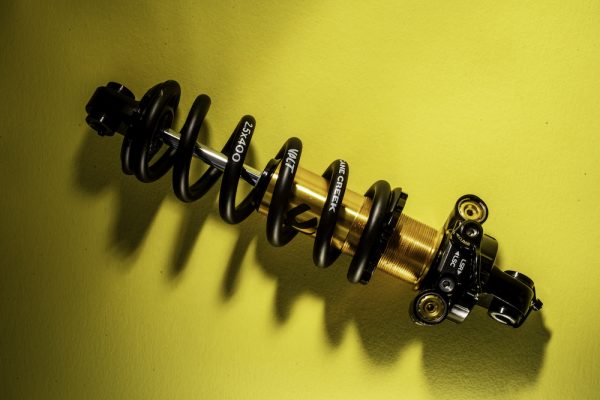A brilliant upgrade
Cane Creek DBCoil InLine shock review
A “rebel shock” built by one of Cane Creek’s coil fanatics. The new Cane Creek DBCoil InLine is a creation that it sure to delight the anti-air brigade.
>>> Should I switch to a coil shock?
Cane Creek’s Double Barrel design is well proven, but the original DB Coil shock is heavier (even with a lightweight spring) and more downhill focussed than many trail or enduro riders need. Cane Creek developed an air-sprung version of the DB coil that saved considerable weight, and then an even lighter, smaller air shock called DB InLine, suitable for shorter travel bikes.
The latest shrunk-down InLine switches to a coil spring for the added performance and consistency some riders want, and the total weight is still very reasonable – roughly 250g heavier than equivalent piggy back air shocks. It sells for £330, which is cheap for such a high-performance after market shock. I added a lightweight (342g) 450lb steel VALT spring to suit my bike and weight that costs an extra £50.
The DB internals work differently to most shocks (although the Fox X2 line and Öhlins have similar variants of the same idea). There’s considerably less oil volume than the original DB, which together with the miniature body saves weight, but the damping oil still circulates continuously through two separate compression and rebound damping circuits, with both sides adjustable for high and low speed hits over a broad range.
I swapped between the DB Coil and Coil IL on a 160mm travel Evil Wreckoning for this test. Both bring an immediate extra dimension of grip and control and a more supportive feel through the mid stroke over the stock Monarch Plus air shock. Another clear benefit is how well the rear tracks multiple hits, roots or beat up tracks (especially on the brakes) coming hot into corners or scrubbing speed on super steep chutes. However, even though Evil’s Delta design is pretty progressive it is easier to use all the travel, so the more linear coil spring won’t suit all bikes.
This InLine has the excellent Climb Switch function that’s superior to a normal lockout and stabilises both sides of the damping for climbing, but here it’s less smooth and controlled than the original DB coil, and had an annoying top-out tap when engaged. In terms of grip and traction, the InLine is another level to most air shocks, but for pure damping control at the limits, maybe more oil is best, as there’s a subtly smoother, more rounded feel from the older, heavier shock absorbing harsh square edges and chatter I couldn’t quite replicate here. Durability was excellent, working hard throughout hard UK winter conditions and multiple weeklong foreign riding trips with zero issues or loss of performance.
I choose a coil shock for maximum performance and am willing to accept the weight penalty of the bigger DB Coil on a long travel 29-er, so I’ll keep that on the Evil.
Verdict
If you want a reliable shock that noticeably increases performance in terms of grip and control, is great value and light enough for even short travel trail bikes though; this DB InLine will make a brilliant upgrade.
















